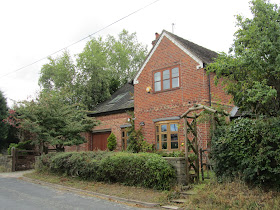My personal challenge for this round of Miss Jenny Matlock's
alphabe-Thursday is to post about a location within the borders of my own county of Derbyshire, UK, for each letter of the alphabet.
Look for the letter, to see where I am.
S is for Stenson
-----------------------------------------------------------------------------------------------------------------------
I've posted photos about parts of Stenson before, so I thought I would complete the picture. These brick built cottages were here well before this road became busy. Now there are traffic calming measures to stop people from speeding past their door.
The name Stenson is old English for Steina's Farm. Stenson is listed in the Domesday Book of 1086, joined with the neighbouring parish of Twyford. Stenson House (above) is the largest house in the village, built by architect Samuel Brown for a tenant of the Harpur-Crewe family.
The settlement is very small; just a dozen or so houses, plus a marina and a pub. This is one of two modern houses.
The Bubble Inn is another recent addition to Stenson; though a 200 year old barn conversion, rather than a new build.
The pub is named after the lock by which it stands; lock and bridge 19 on the Trent and Mersey Canal. The Trent and Mersey was constructed in 1796 and followed the old boundary between Stenson and Twyford, effectively separating the two parishes. The lock is known as The Bubble because of the way the water bubbles from the outflow when the lock is active.
What is now a small tea room was originally the lock keeper's cottage, built in 1810.
Stenson Marina is rather more recent, developed in 1974 from the lay-by above the upper lock. It has approximately 80 moorings and a yard for servicing and repairs. Alongside the marina is also a boatbuilders yard where new narrow boats are built to order.
A narrow boat was being launched into the marina while we were there.
Trent and Mersey Bridge 19 is narrow, only allowing one car to pass at a time. Beyond it is the bridge over the railway line.
The public footpath follows the canal towpath, so named because it was laid for the horses which towed the canal barges before they were powered. This side is below the lower lock gate and is often frequented by fishermen hoping to catch fish disturbed by the emptying lock.
I enjoy walking along the canals and have been down here many times.


















































